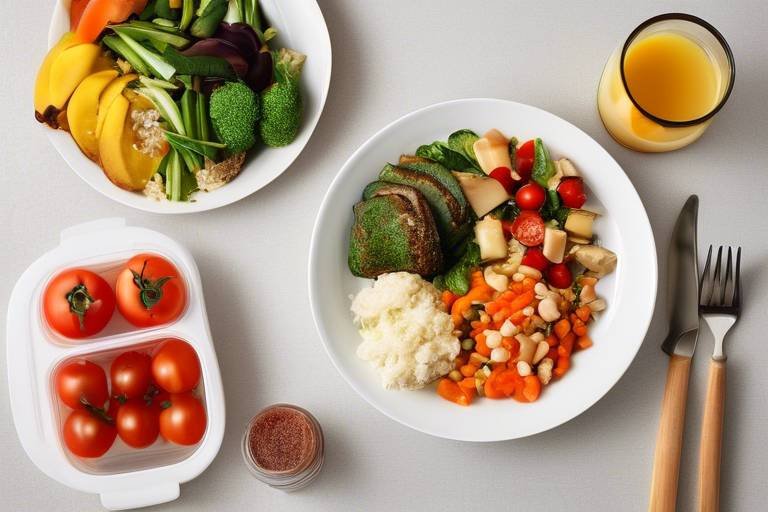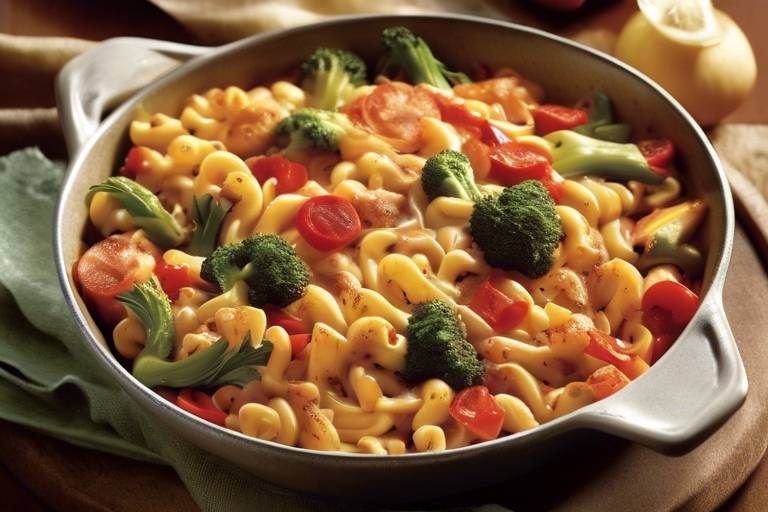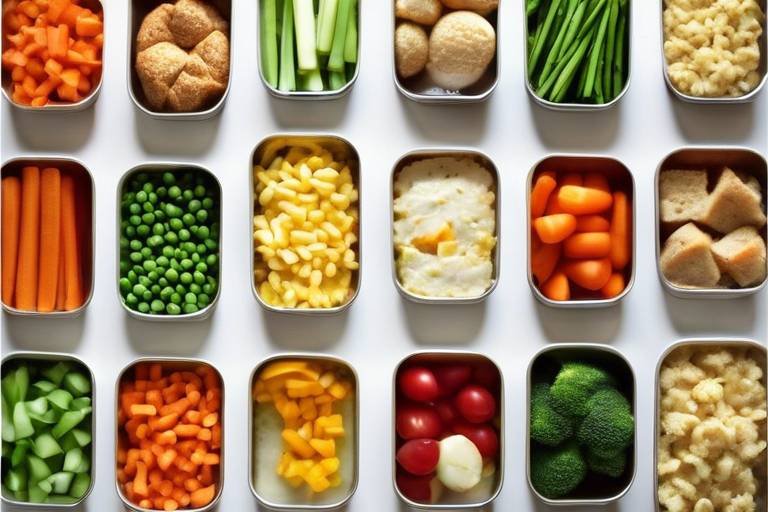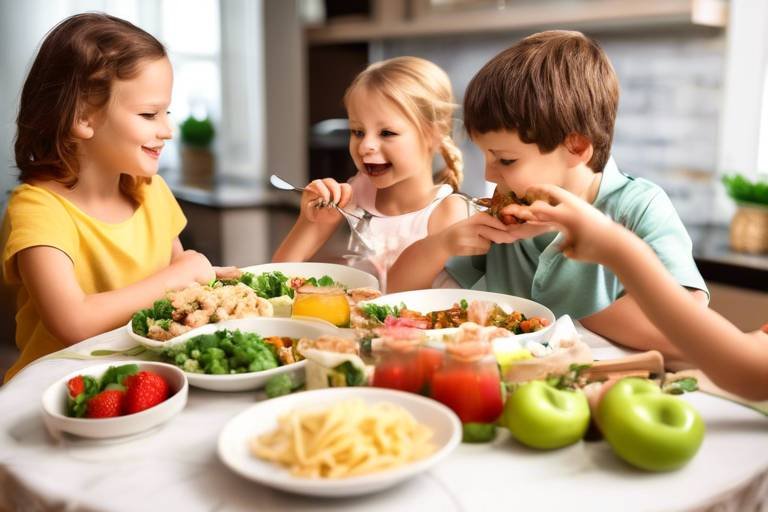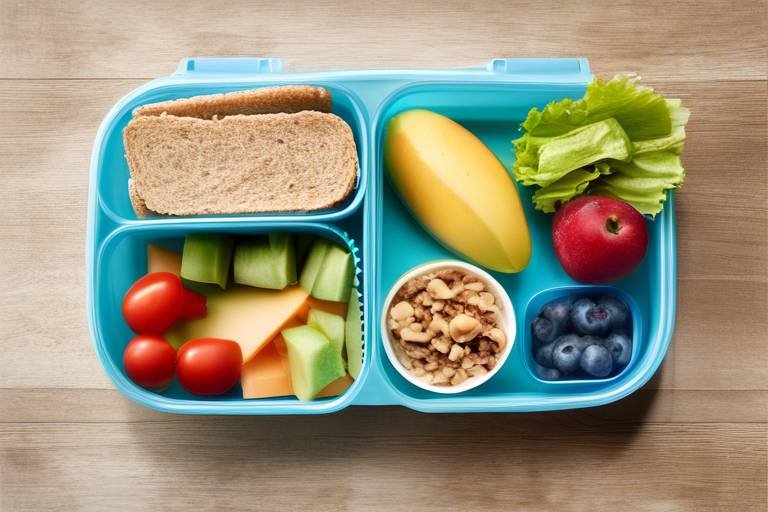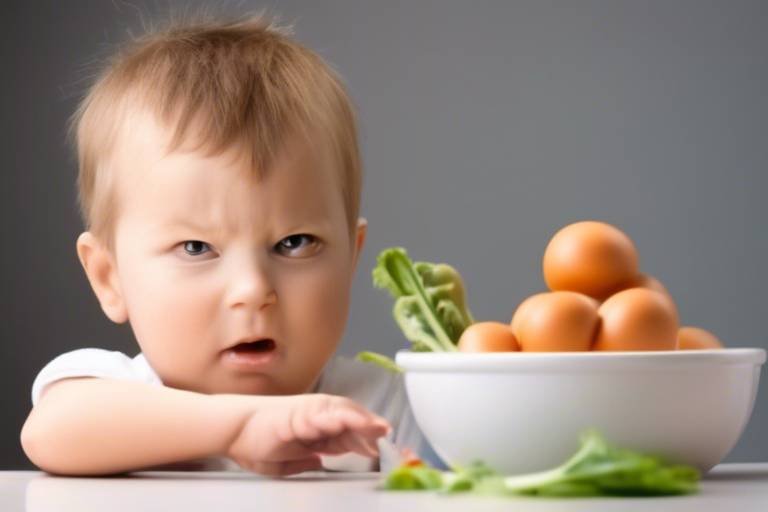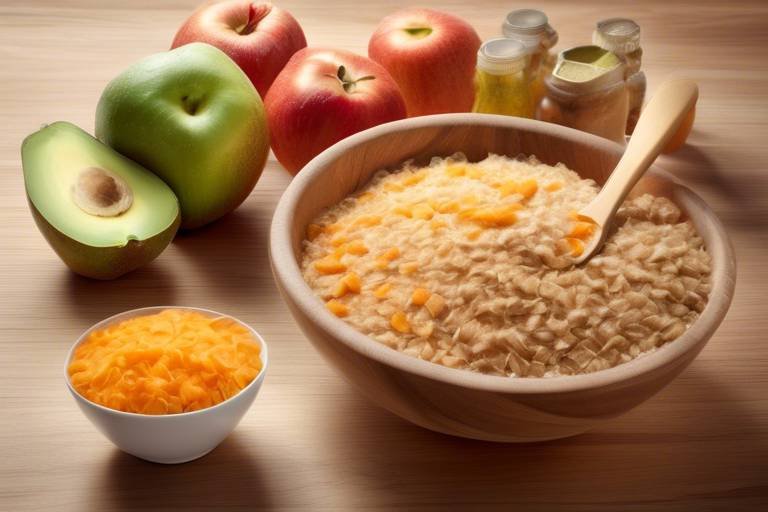Creating Colorful and Nutritious Meals for Kids
Welcome to the exciting world of colorful and nutritious meals for kids! As parents, caregivers, or anyone involved in a child's life, we all understand the struggle of getting them to eat healthy. It can feel like a never-ending battle, right? But what if I told you that making healthy meals can be both fun and engaging? Yes, you heard it right! By focusing on nutrition, presentation, and involving kids in the cooking process, we can create meals that not only nourish their bodies but also delight their senses.
In this article, we’ll explore the importance of nutrition, dive into the world of colorful ingredients, and share some easy recipes that are sure to make mealtime a hit. So, grab your aprons, and let’s get ready to whip up some magic in the kitchen!
Understanding the nutritional needs of children is crucial for their growth and development. Kids are like little sponges, soaking up everything around them, including the nutrients they need to thrive. Essential vitamins and minerals play a vital role in their health. For example, calcium helps build strong bones, while iron is essential for energy and concentration. By providing balanced meals, we ensure that our kids are not just satisfied but also energized and ready to take on the world!
Have you ever noticed how a plate filled with vibrant colors looks more appetizing? That's the magic of colorful ingredients! Incorporating a variety of fruits and vegetables not only enhances visual appeal but also provides a range of nutrients. Think about it: when you see a rainbow of colors on your child's plate, it’s a sign that they are getting a multitude of vitamins, minerals, and antioxidants.
Fruits and vegetables are the superheroes of the food world! They are packed with vitamins and antioxidants that support overall health. For instance, carrots are great for vision, while berries are known for their high antioxidant content. It's essential to include these food groups in children's diets to help them grow strong and healthy. So, how do we make these superheroes more appealing? By making them fun!
Imagine serving a plate of broccoli shaped like a tree or a fruit salad arranged in a rainbow! Presenting food in fun shapes and colors can encourage kids to eat healthier. Here are a few tips to make meals visually appealing:
- Use cookie cutters: Create fun shapes with fruits, vegetables, and sandwiches.
- Colorful bowls: Use colorful plates or bowls to make the food pop.
- Food art: Arrange food to create faces or animals.
Exploring unique flavor combinations can make healthy foods more enticing. For example, pairing peanut butter with banana or mixing yogurt with berries can create delicious and nutritious snacks. Encourage your kids to experiment with different flavors, and who knows? They might discover their new favorite dish!
Getting children involved in meal preparation is a fantastic way to foster healthy habits. When kids help in the kitchen, they are more likely to try new foods and appreciate the effort that goes into making meals. Here are some strategies for engaging kids in the cooking process:
- Let them choose: Allow kids to pick out fruits and vegetables during grocery shopping.
- Assign tasks: Give them age-appropriate tasks, like washing veggies or stirring ingredients.
- Make it a family affair: Turn cooking into a fun family activity, complete with music and laughter.
Now that we’ve covered the essentials, let’s dive into some simple, nutritious, and colorful recipes that kids will love. Each recipe is designed to be easy to prepare and visually appealing, ensuring that mealtime is a delightful experience!
Starting the day with a nutritious breakfast is vital. Here are some creative breakfast ideas that are both healthy and appealing to kids:
- Rainbow Smoothie: Blend spinach, banana, and berries for a colorful drink.
- Pancake Faces: Use fruit slices to create fun faces on pancakes.
Healthy snacks can keep kids energized throughout the day. Here are some nutritious snack options that are easy to prepare and fun to eat:
- Veggie Sticks with Hummus: Colorful carrot and cucumber sticks served with hummus.
- Fruit Kabobs: Skewers of assorted fruits for a fun and healthy treat.
Here are some common questions parents have about creating nutritious meals for kids:
- How can I encourage my child to try new foods? Involve them in the cooking process and make it fun!
- What are some quick healthy snacks? Fruits, yogurt, and nuts are great options!

The Importance of Nutrition
Understanding the nutritional needs of children is crucial for their growth and development. Kids are like little sponges, soaking up everything around them, and what they eat plays a significant role in shaping their health and future. A balanced diet rich in vitamins and minerals is essential for their physical and cognitive development. But what does this really mean? Well, let's break it down!
Children require a variety of nutrients to thrive. Essential vitamins and minerals such as calcium, iron, vitamin D, and omega-3 fatty acids are vital for building strong bones, boosting brain function, and supporting overall well-being. For instance, calcium is not only crucial for developing healthy bones and teeth, but it also plays a role in muscle function and nerve transmission. Iron, on the other hand, is essential for creating hemoglobin, which carries oxygen in the blood, and is particularly important for growing children who are active and energetic.
To give you a clearer picture, here’s a simple table highlighting some key nutrients and their benefits:
| Nutrient | Benefits |
|---|---|
| Calcium | Strengthens bones and teeth, aids muscle function |
| Iron | Supports oxygen transport in the body, boosts energy levels |
| Vitamin D | Enhances calcium absorption, supports immune function |
| Omega-3 Fatty Acids | Promotes brain health, reduces inflammation |
Moreover, it's not just about the nutrients but also about how these foods are presented to kids. Have you ever noticed how a colorful plate can make a meal look more appealing? When children see a variety of colors on their plate, they are more likely to be curious and willing to try new foods. This is where the concept of food variety comes into play. Incorporating different food groups ensures that children receive a wide range of nutrients, making their meals more balanced.
In addition to physical health, nutrition also plays a significant role in mental well-being. Studies have shown that a diet rich in fruits, vegetables, whole grains, and lean proteins can improve mood and cognitive function. So, when you’re planning meals, think about how you can create not just a plate full of food but a plate full of happiness and health!
So, the next time you’re cooking for your little ones, remember that each ingredient is a building block for their future. By ensuring they receive the right nutrients, you’re setting them up for success, both in school and in life. Isn’t that a powerful reason to pay attention to what goes into their meals?
In conclusion, nutrition is not just about filling bellies; it's about nourishing young minds and bodies. By focusing on providing balanced meals filled with essential nutrients, you can help your children grow into healthy, happy adults.

Colorful Ingredients
When it comes to preparing meals for kids, one of the most effective strategies is to focus on . Not only do these vibrant foods look appealing on the plate, but they also pack a punch in terms of nutrition. Think of a rainbow—each color represents a different set of nutrients that contribute to a child's overall health. For instance, red foods like tomatoes and strawberries are rich in vitamin C and antioxidants, while orange ingredients like carrots and sweet potatoes provide a hefty dose of beta-carotene, crucial for eye health.
Incorporating a variety of colorful fruits and vegetables into your child's meals can be as simple as creating a colorful plate. Aim for at least three different colors in every meal. This not only makes the food visually appealing but also ensures a broader spectrum of vitamins and minerals. Here’s a quick breakdown of some colorful ingredients and their benefits:
| Color | Examples | Nutritional Benefits |
|---|---|---|
| Red | Tomatoes, Strawberries, Red Peppers | Rich in Vitamin C, antioxidants, and lycopene for heart health |
| Orange | Carrots, Sweet Potatoes, Oranges | High in beta-carotene, Vitamin A, and fiber for digestion |
| Green | Broccoli, Spinach, Green Apples | Loaded with iron, calcium, and vitamins K and C for strong bones |
| Blue/Purple | Blueberries, Eggplants, Purple Cabbage | Contains anthocyanins for brain health and memory |
By offering a variety of colors, you can also introduce your kids to new flavors and textures. For example, why not create a rainbow salad with mixed greens, cherry tomatoes, shredded carrots, and purple cabbage? The crunchiness of the vegetables combined with a light vinaigrette can make for a delightful meal that is not only nutritious but also fun to eat. Kids are naturally curious, and presenting food in an exciting way can spark their interest and make them more willing to try new things.
Moreover, it’s essential to teach children about the different colors and their benefits. You can turn this into a fun learning experience by asking them questions like, “What color do you think is the healthiest?” or “Which fruit do you think has the most vitamins?” By engaging them in this way, you’re not just feeding their bodies; you’re also feeding their minds.
In conclusion, colorful ingredients are not just about aesthetics; they play a significant role in ensuring that children receive a balanced diet. The next time you’re in the kitchen, remember that the more colors you can incorporate into your meals, the more nutrients you’re providing for your little ones. So, let’s get creative and make healthy eating a colorful adventure!

Fruits and Vegetables
When it comes to our little ones, are not just colorful decorations on their plates; they are the powerhouses of nutrition that fuel their growth and development. Imagine a world where your kids are not just eating, but enjoying every bite of their meals, all while reaping the benefits of essential vitamins and minerals. Incorporating a variety of fruits and vegetables into their diets is like giving them a rainbow of health, each color representing different nutrients that play a pivotal role in their overall well-being.
Fruits and vegetables are brimming with vitamins and antioxidants that help shield our children from illnesses, boost their immune systems, and promote healthy skin and eyes. For instance, carrots are rich in Vitamin A, which is crucial for good vision, while oranges are packed with Vitamin C, helping to ward off colds. It's not just about what these foods contain; it's also about the fun and excitement they can bring to the table. The more colorful the plate, the more appealing it looks, and the more likely kids are to dive in.
To make sure your kids are getting a wide array of nutrients, aim for a variety of fruits and vegetables in different colors. Here’s a quick breakdown of some colorful choices and their benefits:
| Color | Fruits | Vegetables | Benefits |
|---|---|---|---|
| Red | Strawberries, Watermelon | Tomatoes, Red Bell Peppers | Rich in antioxidants, support heart health. |
| Orange | Oranges, Peaches | Carrots, Sweet Potatoes | High in Vitamin A, supports vision and immune function. |
| Green | Kiwi, Green Apples | Spinach, Broccoli | Loaded with iron and calcium, promotes strong bones. |
| Yellow | Bananas, Pineapple | Yellow Squash, Corn | Provides energy and improves digestion. |
| Purple | Grapes, Plums | Eggplant, Purple Cabbage | Contains anthocyanins, which may improve brain health. |
By introducing a spectrum of colors into meals, you're not just making food look appealing; you're also teaching your kids the importance of a balanced diet. Encourage them to choose their favorites from the rainbow of options available. You might even turn it into a fun game—who can eat the most colors in one day? This playful approach not only makes eating healthy exciting but also instills a sense of curiosity about different foods.
Moreover, getting creative with fruits and vegetables can lead to delightful culinary experiences. Think of a fruit salad bursting with colors or a vibrant vegetable stir-fry that looks like a painter's palette. The key is to make these foods accessible and fun. By involving kids in the selection and preparation process, they are more likely to eat what they help create. So, let them pick the produce during grocery shopping, or have them wash and arrange the veggies in fun shapes on their plates!
In conclusion, incorporating a variety of fruits and vegetables into your child’s diet is essential for their health and growth. Not only do these foods provide vital nutrients, but they also offer a delicious way to engage kids in healthy eating habits. So, let’s embrace the colorful world of fruits and vegetables and watch our children thrive!

Creative Presentation
When it comes to getting kids excited about healthy eating, can be a game-changer. Imagine serving a plate that looks like a rainbow or resembles their favorite cartoon character! The art of making food visually appealing can transform a mundane meal into an exciting adventure. Kids are naturally curious and often eat with their eyes first, so why not make their plates as vibrant and inviting as possible?
One effective way to enhance the visual appeal of meals is by using fun shapes and colors. For instance, using cookie cutters to create star-shaped sandwiches or fruit can instantly grab their attention. You can also consider arranging vegetables to form a smiley face or creating a colorful fruit salad that resembles a work of art. The key is to be playful and imaginative—after all, food is not just about sustenance; it's also about enjoyment!
Another fantastic strategy is to incorporate a variety of textures. Mixing crunchy, soft, and smooth foods can create an interesting experience for little taste buds. Think about combining crispy cucumber slices with creamy avocado or pairing crunchy carrot sticks with a smooth hummus dip. This not only makes the meal more enjoyable but also encourages kids to explore different flavors and textures. Remember, presentation can also enhance the taste perception; a beautifully arranged plate can make even the simplest dish seem gourmet!
Using colorful ingredients is essential for creative presentation. Aim to fill the plate with a spectrum of colors. A vibrant salad with leafy greens, bright cherry tomatoes, orange carrots, and purple cabbage can be both nutritious and visually stunning. You might even want to create a color wheel of fruits and vegetables, encouraging kids to choose a variety of colors for their meals. This not only makes eating fun but also ensures they are getting a wide range of nutrients.
Lastly, don't forget to involve the kids in the presentation process! Let them help arrange their meals or choose the colors they want on their plates. This involvement can spark their interest in healthy eating and give them a sense of ownership over their food. When children feel like they had a hand in creating their meals, they are more likely to try new things. So, next time you're in the kitchen, unleash your creativity and watch as your little ones dive into their colorful and nutritious creations!
- Why is presentation important for kids' meals? Kids are visual learners, and an appealing presentation can entice them to try new foods and make healthy eating more enjoyable.
- How can I make healthy meals more fun? Use colorful ingredients, fun shapes, and let kids help with the presentation to make meals exciting.
- Are there specific shapes that work best for kids? Shapes like stars, hearts, and animals are often favorites among children, making them more likely to eat their meals.

Flavor Combinations
When it comes to making healthy food exciting for kids, exploring unique flavor combinations can work wonders! Think of it as a culinary adventure where every meal is a chance to discover something new. Just like mixing colors on a palette to create a masterpiece, combining different flavors can transform simple ingredients into a delightful experience. Have you ever noticed how a dash of cinnamon can elevate a bowl of oatmeal, or how a hint of vanilla can make fruit salad sing? These little tweaks can turn ordinary dishes into extraordinary ones that kids will actually want to eat!
One of the best ways to introduce your children to new flavors is by pairing familiar tastes with something unexpected. For instance, try mixing sweet and savory—like adding a sprinkle of cheese on top of sweet potato pancakes. The contrast not only makes the dish more interesting but also encourages kids to experiment with their food. You can also play with textures; crunchy veggies paired with creamy dips can create a fun eating experience. Think about how much kids love to dip! Here are some ideas to get you started:
- Peanut Butter & Banana: A classic combo that never fails! Spread peanut butter on whole grain toast and top it with banana slices for a nutritious snack.
- Yogurt & Berries: Mix plain yogurt with a variety of berries. The tartness of the berries balances the creaminess of the yogurt, making it a hit.
- Carrots & Hummus: The crunchy sweetness of carrots dipped in creamy hummus is not just healthy; it's also a fun way for kids to enjoy their veggies.
Another exciting avenue to explore is herbs and spices. Adding fresh herbs like basil or mint can completely change the flavor profile of a dish, making it more appealing. For example, tossing some basil into a tomato and mozzarella salad can make it taste like summer, while a sprinkle of cinnamon in a fruit salad can bring warmth and sweetness. Encourage your kids to taste as they cook, allowing them to discover what flavors they enjoy the most. This not only makes them more invested in their meals but also helps them develop their palates.
Finally, don't forget about the power of citrus. A squeeze of lemon or lime can brighten up any dish, adding a zesty kick that kids might find refreshing. Try drizzling lemon juice over steamed broccoli or adding lime to a fruit smoothie for an extra zing. The bright flavors can make healthy eating feel like a treat rather than a chore.
In conclusion, experimenting with flavor combinations is a fantastic way to make healthy meals more enticing for kids. By introducing them to a variety of tastes, textures, and aromas, you’re not just feeding their bodies; you’re also feeding their curiosity and creativity in the kitchen. So grab those ingredients, get chopping, and let the flavor exploration begin!
Q: How can I encourage my kids to try new flavors?
A: Start by introducing one new ingredient at a time and pair it with something they already love. Make it a fun experience by letting them help in the kitchen!
Q: What are some easy flavor combinations for kids?
A: Some easy combinations include peanut butter with apples, yogurt with honey and granola, and cheese with whole grain crackers. These are not only tasty but also nutritious!
Q: How can I make vegetables more appealing?
A: Try roasting vegetables with a sprinkle of olive oil and herbs, or serve them with a fun dip like ranch or hummus. Presentation also matters—cutting veggies into fun shapes can make them more enticing!

Involving Kids in Cooking
Getting kids involved in the kitchen is like opening a treasure chest filled with opportunities for fun, learning, and bonding. When you invite them to help prepare meals, you're not just teaching them how to cook; you're also instilling essential life skills that will benefit them for years to come. Imagine the joy on their faces when they get to mix, chop, and create delicious dishes that they can proudly say, "I made this!"
One of the best parts about involving children in cooking is that it turns a mundane task into an exciting adventure. You can start by assigning them simple, age-appropriate tasks. For instance, younger kids can wash veggies or stir ingredients, while older children can help with chopping or measuring. This hands-on experience not only makes them feel included but also nurtures their confidence in the kitchen.
Moreover, cooking together allows for valuable teaching moments. You can discuss the importance of nutrition and how different ingredients contribute to a healthy diet. For example, while preparing a colorful salad, you can talk about the vitamins in tomatoes, the fiber in cucumbers, and how these nutrients help them grow strong. This kind of engagement helps children develop a positive relationship with food, which is crucial in today’s fast-paced world filled with processed options.
To make the experience even more enjoyable, consider turning cooking into a game. You might say, "Let's see who can chop the veggies the fastest!" or "Who can create the most colorful plate?" This not only keeps their enthusiasm high but also encourages creativity. Let them experiment with flavors and textures, and you might be surprised by the unique combinations they come up with!
Here are a few tips to make cooking with kids even more rewarding:
- Make it a family affair: Schedule a regular cooking night where everyone can participate. This creates a sense of routine and excitement.
- Explore new recipes: Encourage kids to choose recipes they want to try. This empowers them and makes them more invested in the cooking process.
- Celebrate their creations: Once the meal is prepared, sit down together to enjoy it. Praise their efforts and enjoy the fruits of your labor as a family.
Ultimately, involving kids in cooking is about more than just preparing meals; it’s about creating lasting memories and fostering a love for healthy eating. So, roll up those sleeves, put on some aprons, and get ready for a culinary adventure that will not only fill their bellies but also their hearts.
Q: At what age can I start involving my kids in cooking?
A: You can start involving kids in cooking as early as 2-3 years old, assigning them simple tasks such as washing vegetables or stirring. As they grow, you can introduce more complex tasks.
Q: How can I keep my kids engaged while cooking?
A: Keep the cooking experience fun by turning it into a game, letting them choose recipes, and celebrating their culinary creations.
Q: What are some safe cooking tasks for young children?
A: Young children can help with washing fruits and vegetables, tearing lettuce, mixing ingredients, and setting the table. Always supervise them closely.
Q: How can I teach my kids about nutrition while cooking?
A: Discuss the nutritional benefits of each ingredient as you cook. For example, explain how carrots are good for eyesight or how whole grains provide energy.

Easy Recipes for Kids
When it comes to preparing meals for children, simplicity and fun are key! Kids are often picky eaters, but with a little creativity, you can whip up nutritious and colorful dishes that they'll actually want to eat. The goal here is to create meals that are not just healthy but also visually appealing and engaging. Let’s dive into some easy recipes that combine exciting flavors and vibrant ingredients!
First up, let’s talk about breakfast! Starting the day with a nutritious meal is crucial for kids, as it sets the tone for their energy levels and concentration. A fun and colorful breakfast idea is the Rainbow Smoothie Bowl. Simply blend a mix of fruits such as bananas, strawberries, and spinach to create a vibrant smoothie base. Pour it into a bowl and let your little ones decorate it with toppings like granola, chia seeds, and more fruits. The best part? They can create their own designs, making breakfast a fun art project!
For a quick snack option, how about Fruit Kabobs? These are not only easy to make but also allow kids to get involved in the kitchen. All you need are some wooden skewers and a variety of fruits like grapes, melon, and pineapple. Let the kids thread the fruits onto the skewers, creating their own colorful combinations. This not only encourages healthy snacking but also helps develop fine motor skills. Plus, who can resist food on a stick?
Lunch can sometimes be a challenge, but a Veggie Wrap can save the day! Start with a whole grain tortilla and spread a layer of hummus or cream cheese. Then, let your kids choose their favorite veggies—think carrots, cucumbers, and bell peppers. Roll it up tightly and slice it into pinwheels. Not only does this meal look appealing, but it’s packed with nutrients and can be customized to suit any taste!
Now, let’s not forget about dinner! A Colorful Quinoa Stir-Fry is a fantastic way to introduce kids to whole grains while incorporating a rainbow of vegetables. Cook some quinoa and set it aside. In a pan, sauté a mix of colorful veggies like bell peppers, broccoli, and snap peas. Toss in the quinoa, add a splash of soy sauce, and voilà! You have a vibrant, nutritious meal that’s sure to impress even the pickiest eaters.
To make your meals even more exciting, consider incorporating a theme night. For example, you could have a taco night where everyone builds their own tacos with various toppings. This not only makes dinner interactive but also encourages kids to try new ingredients in a fun way.
Here’s a quick reference table for some easy meal ideas:
| Meal Type | Recipe | Key Ingredients |
|---|---|---|
| Breakfast | Rainbow Smoothie Bowl | Bananas, strawberries, spinach, granola |
| Snack | Fruit Kabobs | Grapes, melon, pineapple |
| Lunch | Veggie Wrap | Whole grain tortilla, hummus, assorted veggies |
| Dinner | Colorful Quinoa Stir-Fry | Quinoa, bell peppers, broccoli, soy sauce |
Incorporating these easy and fun recipes into your meal planning can transform the way your kids view healthy eating. When meals are colorful, interactive, and involve them in the cooking process, children are more likely to embrace nutritious foods. So roll up your sleeves, get creative, and make mealtime a delightful experience for the whole family!
Q: How can I get my kids to try new foods?
A: One effective way is to involve them in the cooking process. When kids help prepare meals, they are more likely to try what they’ve made. Also, presenting food in fun shapes or colors can pique their interest!
Q: What are some quick snack ideas for kids?
A: Some quick and healthy snack ideas include yogurt with fruit, apple slices with peanut butter, or whole-grain crackers with cheese. You can also make fun snacks like fruit kabobs for a more engaging experience.
Q: Are there any meal prep tips for busy parents?
A: Absolutely! You can prepare ingredients in advance, such as chopping vegetables or cooking grains, and store them in the fridge. This way, you can assemble meals quickly during the week without sacrificing nutrition.

Breakfast Ideas
Starting the day with a nutritious breakfast is vital for children, as it sets the tone for their energy levels and focus throughout the day. Think of breakfast as the fuel that powers a race car; without high-quality fuel, performance suffers. But let’s be honest—getting kids excited about breakfast can sometimes feel like trying to convince a cat to take a bath! So, how do we make breakfast not just nutritious but also fun and appealing?
One fantastic approach is to incorporate vibrant colors and interesting textures into breakfast dishes. For instance, consider creating a rainbow smoothie bowl. Blend up a mix of fruits like bananas, strawberries, and spinach for a burst of color. Pour it into a bowl and let your kids top it with their favorite ingredients, such as granola, nuts, or seeds. Not only does this dish look amazing, but it also packs a nutritional punch with essential vitamins and minerals.
Another simple yet delightful breakfast idea is whole grain pancakes. You can sneak in some healthy ingredients like mashed bananas or grated zucchini right into the batter. When these pancakes are served, they can be topped with a drizzle of honey and a colorful array of berries. The combination of flavors will have your little ones asking for seconds!
For a more savory option, consider making vegetable omelets. Get creative with the fillings! You can include colorful bell peppers, spinach, and even some cheese to make it more enticing. The best part? Letting your kids choose their own toppings can turn breakfast into an exciting adventure. Just imagine the joy on their faces when they see their personalized omelet come to life!
If you’re short on time, overnight oats are a lifesaver. Simply mix rolled oats with yogurt or milk and let them soak overnight. In the morning, add a variety of toppings such as sliced fruits, nuts, or a sprinkle of cinnamon. This not only makes breakfast quick and easy but also allows for endless combinations that can keep things fresh and exciting.
To make breakfast even more engaging, consider creating a breakfast bar. Set up a table with different options like yogurt, fruits, nuts, and whole grain cereals. Let the kids assemble their own breakfast creations. This way, they feel involved in the process, and you can sneak in some healthy choices without them even realizing it!
In summary, breakfast doesn’t have to be a mundane routine. With a little creativity and a splash of color, you can turn it into a delightful experience that your kids will look forward to. Remember, the key is to keep it fun, engaging, and packed with nutrition. After all, a happy, well-fed child is a recipe for a successful day!
Q: What are some quick breakfast options for busy mornings?
A: Smoothies, overnight oats, and yogurt parfaits can be prepared quickly and are nutritious. You can also make whole grain toast with nut butter for a filling option.
Q: How can I encourage my kids to try new breakfast foods?
A: Involve them in the cooking process, let them pick toppings, and present the food in fun shapes or colors. Making breakfast interactive can spark their interest!
Q: Are there any breakfast foods I should avoid?
A: Try to limit sugary cereals and pastries. Instead, focus on whole grains, fruits, and proteins to provide sustained energy for your kids.

Snack Options
When it comes to keeping kids energized and satisfied throughout the day, offering healthy snacks is key. Snacks can be more than just a quick bite; they can be an opportunity to introduce a variety of nutritious ingredients into your child's diet. Think of snacks as mini-meals that can help bridge the gap between breakfast and lunch or lunch and dinner. By choosing the right snacks, you can provide essential vitamins, minerals, and energy that children need to fuel their busy lives.
One of the best approaches to creating enticing snacks is to focus on colorful and fun presentations. Kids are naturally drawn to bright colors and interesting shapes. For example, consider serving a vibrant rainbow of fruits and vegetables. You can create a snack platter that includes red strawberries, orange carrots, yellow bell peppers, green cucumbers, and blue blueberries. Not only does it look appealing, but it also provides a variety of nutrients that are essential for their growth and development.
Another fantastic idea is to incorporate whole grains into your snacks. Whole grain options, such as whole grain crackers or popcorn, can be paired with healthy dips like hummus or guacamole. This not only adds flavor but also boosts the fiber content, helping to keep kids feeling full longer. You might be surprised how much they enjoy dipping their snacks! Here are a few creative snack ideas that you can easily prepare:
- Fruit Kabobs: Thread a mix of fruits onto skewers for a fun, portable snack.
- Yogurt Parfaits: Layer yogurt with granola and fresh fruits in a clear cup for a visually appealing treat.
- Veggie Faces: Use sliced vegetables and hummus to create funny faces on a plate, making healthy eating playful.
In addition to these fun ideas, it's essential to consider nutritional balance. Aim for a combination of carbohydrates, protein, and healthy fats in each snack. For example, pairing apple slices with almond butter not only satisfies a sweet tooth but also provides protein and healthy fats, making it a well-rounded choice. Remember, the goal is to create snacks that are not only delicious but also nourishing.
Lastly, don’t forget about the power of involvement. Encourage your kids to help in the kitchen by letting them choose their favorite fruits and vegetables or even helping to prepare the snacks. This not only makes them more excited about eating healthy but also teaches them valuable skills in the kitchen. By making snack time a fun and interactive experience, you’ll help instill lifelong healthy eating habits.
Q: What are some quick and healthy snack ideas for kids?
A: Some quick options include yogurt with fruit, whole grain crackers with cheese, or sliced veggies with hummus. These snacks are nutritious and easy to prepare!
Q: How can I encourage my kids to try new snacks?
A: Involve them in the snack-making process! Let them choose ingredients or help prepare the snacks. Making it a fun activity can spark their interest in trying new foods.
Q: Are there any snacks I should avoid giving to my kids?
A: It's best to limit snacks that are high in sugar, artificial ingredients, or unhealthy fats. Opt for whole, minimally processed foods whenever possible.
Frequently Asked Questions
- Why is nutrition important for kids?
Nutrition is crucial for children as it supports their growth and development. A balanced diet rich in essential vitamins and minerals helps kids build strong bones, develop their immune systems, and maintain energy levels for play and learning.
- How can I make meals more appealing to my kids?
Making meals visually appealing is all about creativity! Use colorful fruits and vegetables, arrange food in fun shapes, and consider using cookie cutters to create interesting designs. Engaging your kids in the cooking process can also spark their interest in trying new foods.
- What are some easy recipes I can try with my kids?
There are plenty of simple recipes that are both nutritious and fun! For breakfast, think about smoothies with colorful fruits or oatmeal topped with berries. For snacks, try making fruit kabobs or yogurt parfaits with layers of granola and fruit. The key is to keep it simple and let your kids participate!
- How can I involve my children in the cooking process?
Involving kids in the kitchen can be a delightful experience! Let them wash vegetables, mix ingredients, or even choose recipes. This not only teaches them valuable skills but also encourages them to appreciate healthy eating habits. Plus, cooking together can be a great bonding activity!
- What are some nutritious snack options for kids?
Nutritious snacks can be both tasty and easy to prepare! Consider options like sliced apples with peanut butter, carrot sticks with hummus, or whole-grain crackers with cheese. These snacks provide energy and essential nutrients without the added sugars found in many processed snacks.
- How do I encourage my kids to try new foods?
Encouraging kids to try new foods can be a fun challenge! Try introducing new ingredients alongside their favorites, and make a game out of it. You can also share fun facts about the food or involve them in the cooking process to pique their curiosity. Remember, patience is key—sometimes it takes several tries before they warm up to something new!



